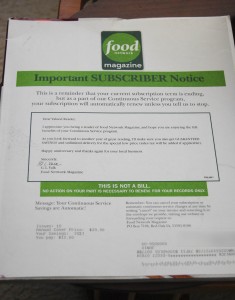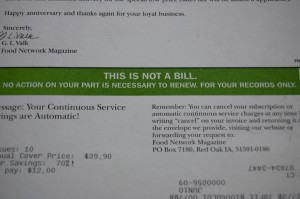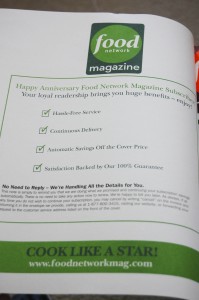I recently received a copy of Food Network magazine–to which I tried a trial subscription a year ago–with this letter pasted to the cover.
“Important Subscriber Notice” is emblazoned across the top, with a warning that, “This is a reminder that your current subscription term is ending, but as a part of our Continuous Service program, your subscription will automatically renew unless you tell us to stop.”
To my knowlege, publishers are legally required to alert people before they are automatically billed for a subscription (a requirement of which I entirely approve). I thought this presentation of that “tickler letter” was pretty creative, first of all.
When I tell you this was pasted onto the cover–I mean exactly that. It wasn’t just an insert into the polybag the magazine arrived in. It wasn’t an “attached renewal” that was stuffed into an envelope in the bag, that saved postage but otherwise looked like a regular renewal. No, this was literally stuck to the cover, like a giant post-it note. Impossible to miss.
It very clearly states that this is not a bill. “No action on your part is necessary to renew.”
All-in-all, pretty clever, right? It makes sure you can’t miss it. It doesn’t permanently deface the actual issue. It’s polite and clear in its message.
There’s only one problem.
There, in the small print? “You can cancel your subscription or automatic continuous service charges at any time by writing ‘cancel’ on your invoice and returning it in the envelope we provide, visiting our website or forwarding your request to….”
First, and most importantly, there was no provided envelope and since this particular letter is NOT a bill … what invoice am I supposed to be writing “cancel” on?
Second, I tried going to the website and … once I found the customer service section (which took a while), there was an option for cancelling the subscription. Except, that looked like it would cancel it right away, instead of just letting it run to expire (which would be my preference), and I didn’t see any option at all for just removing the “auto-renew” code so that I could get regular, printed renewal notices, which would be my second choice.
I didn’t hate the magazine, you see, but I don’t remember signing up for the automatic-renewal program (hence the legal requirement of the reminder). I just prefer to be the one to decide when and if my magazine subscriptions get renewed, so the fact that I somehow got entered as an auto-renew sub … my guess is there was small print on the original direct mail order card I sent back … is not my preference.
They didn’t waste the inside/back of the letter, either, but took the chance to remind readers of all the benefits of subscribing. Because, it would have been silly to leave the flip side empty, right?
One more note–I liked the judicious use of color. The entire piece is primarily black and white, except for a few elements in shades of green–just enough to catch your eye, but not enough to be (1) distracting or (2) overly expensive to print. The actual letter text (“Dear Valued Reader, I appreciate you being a reader…”) is in a box that visually separates it from the “jargon,” if you will. It’s actually the least important part of this page, and therefore printed in a smaller font, and kept separate, like a sidebar.
Ultimately, I liked this delivery method, I thought it was creative and effective. When you write direct mail pieces or subscription letters, you DREAM of having fool-proof ways of making somebody at least see (if not read) your piece.
I just wish whoever had written this had thought through the “write cancel and return in the envelope” bit a little more carefully. It’s like a glaring error in an otherwise perfect piece.
Edited to add: It’s good that I held this before publishing this post because about two weeks later, I got an Invoice in the mail saying it was for the automatic renewal, and please pay now. It doesn’t seem very cost-effective, but at least it explains what invoice they meant I should write “cancel” on if I wasn’t interested.





A few years ago I received a bill stating that I had signed up for an automatic renewal of a magazine subscription. The problem was I’m sure I did not sign up for automatic renewal. Maybe it was a data entry mistake on the part of the magazine, but cynical me doesn’t think so. It felt like my choice to continue or not continue my subscription had been taken away from me. I decided to no longer subscribe to magazines that I could pick up at the local newsstand, even if it costs more. I think it’s a sneaky thing to do on the part of magazine marketers.
The only magazine I subscribe to today is one that is not available locally. So far that publisher has not used underhanded tactics to get me to renew.
.-= Marilyn´s last blog ..BTT: Illustrious =-.
I got caught by one of those sneaky auto-renewal subscriptions years ago, too, but that was before it was as well-regulated as it is now. In the U.S. at least, they cannot automatically subscribe you without telling you so and giving you the option to say “no.” It can be in the fine print on the order form, but it needs to be there somewhere. They also need to alert you before the automatic renewal goes through, so you have a chance to say “I changed my mind” before your credit card gets charged.
I admit, I still prefer to pay for my own subscriptions via check rather than credit card, mostly because I like to keep control over this sort of thing, too, but since auto-renewal is often paired with some really tempting subscription rates, it’s worth at least thinking about.
I’m glad I don’t work for such a magazine, because I don’t approve of such tactics. I think you should have to make an effort to renew, not to cancel. Grrr.
.-= J´s last blog ..Friday Randomness =-.
Deb,
I agree you should have to make the effort to subscribe unless YOU request auto-renew.
I have awarded your blog the Happy 101 Award. Visit my blog for the details.
.-= Lillie Ammann´s last blog ..Happy 101 Award =-.
The rule is that the publisher must tell you in advance–before signing you up, and each year before actually billing you. This can be accomplished in small print at the bottom of a bind-in card or a direct mail piece. (“Unless you say not to, we will sign you up for our convenient automatic-renewal, which is so much more convenient than having to remember to renew.”) But it has to be SOMEWHERE that you can say “No thank you”. They can’t just sign you up for the program willy-nilly.
.-= –Deb´s last blog ..Auto-Renewal Notification Review =-.
I subscribed to this magazine and after the first year decided not to renew.
I then received an invoice stating that I owed for 1 year. Stupid me..I paid it
thinking that I had missed the original payment. Again the subscription ran out and AGAIN I got the same invoice. This time I was on to their con game.
I sent them an email and cancelled. They must be hard up to use such tactics.
Brian–Of course, that IS the point of automatic-renewal. They keep renewing your subscription at the end of term until you tell them to stop. It helps the publisher because they don’t have to spend money on renewal notices and it helps the subscriber because they don’t need to worry about their subscription lapsing and they usually get the best available price. As long as the publisher is clear up-front about their offer being connected to automatic-renewal, there’s no “con” to it at all. More and more publishers offer it these days.
All of my magazine subscriptions are now auto-renew; and nowhere did I see an option to skip the auto-renew. my subscriptions include Town and Country, Woman’s Day, Victoria Magazine, Southern Living, and Metropolitan Homes. Auto-renew is a scam to get people to spend more money than they would otherwise. I pay by check, and Woman’s Day sent me a notice that they would report me to the credit bureau as a delinquent account if I didn’t send them money. It isn’t easy to cancel, either, if you haven’t tried. They make it very difficult; I had to send 3 cancel notices to one magazine before they would cancel my subscription.
I too have just been charged as an auto-renew customer, to Pay Pal of all methods. Southern Living Magazine did this, multiple e mail sent by me went unanswered, the phone calls I made met with a message saying their phone response service was out of order. Finally I have received response saying they will ‘consider’ refunding my payment but it will take 60 days. What a scam, hope to never see this publication again.
Obviously some publishers are better about the alerts than others, and I think they expect a certain percentage of “I never ordered this” protests, but there have been some big lawsuits about this issue and so far as I know, publishers DO mention this in their advertising. It’s just often smallllllll print. And sometimes it’s “We’ll sign you up unless you tell us not to” and it’s almost always couched in “this will be so convenient for you” kind of language.
But, yeah. I pay all my own magazine subscriptions the old-fashioned way–by check.
I have been turned over to a collection agency for not paying for an unauthorized magazine subscription. I don’t recall getting a notice that it would be renewed but I usually trash any mail from these companies. I spoke with the USPS and have been told I don’t have to pay for something I didn’t order. Which is it? I don’t think TN has a law against this. I will never subscribe to anothe magazine because of this practice which I consider unlawful.